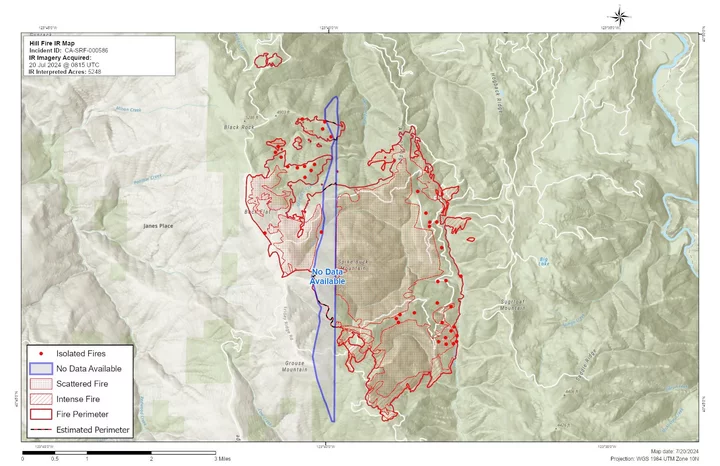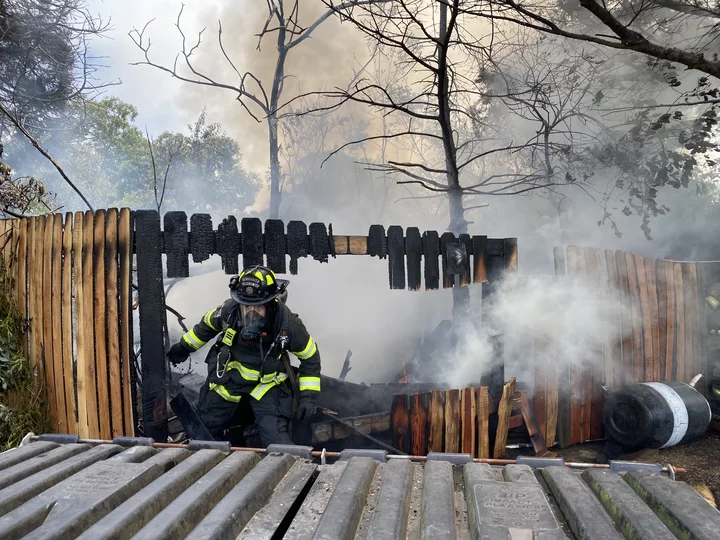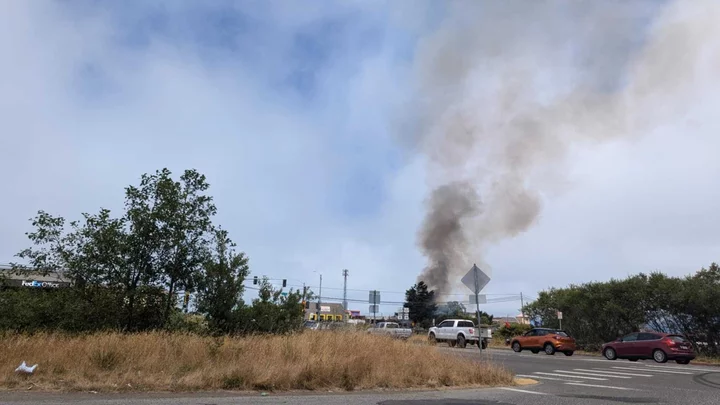McGuire Issues Statement on Biden’s Decision to Drop Out of the 2024 Presidential Race
LoCO Staff / Sunday, July 21, 2024 @ 11:43 a.m. / Politics
###
Shortly after today’s historic announcement from President Joe Biden that he will not accept the Democratic nomination and will instead endorse Vice President Kamala Harris as his successor, North Coast Senator and California Senate Leader Mike McGuire issued the following statement:

McGuire | Source
President Biden has led our nation with incredible skill, heart, and determination. His presidency has implemented generational change.
Through his leadership, America’s economy is back from the abyss, he’s created a record number of jobs for working families, he’s reinvested in rural America, doubled the stock market, stood strong for reproductive rights and, because of his steady hand, America is back as a beacon of hope for the rest of the world.
His leadership has been nothing short of tremendous, especially coming out of a global pandemic. California is deeply grateful for his tireless dedication to this nation we all love to call home.
BOOKED
Today: 8 felonies, 6 misdemeanors, 0 infractions
JUDGED
Humboldt County Superior Court Calendar: Yesterday
CHP REPORTS
776 Singley Hill Rd (HM office): Animal Hazard
7777 Mm101 N Men 77.80 (HM office): Traffic Hazard
Sr162 / Laytonville Dos Rios Rd (HM office): Trfc Collision-No Inj
Sr1 / Us101 (HM office): Closure of a Road
Alderpoint Rd / Cemetery Rd (HM office): Traffic Hazard
ELSEWHERE
RHBB: Highway 1 Blocked at Leggett Due to Slide
Mad River Union: Arcata Fire news release on the downtown fire
GROWING OLD UNGRACEFULLY: Lighten Up!
Barry Evans / Sunday, July 21, 2024 @ 7 a.m. / Growing Old Ungracefully
I’ve been told to lighten up with these weekly rants. I hear and obey:
###
Fortune favors the lucky.
— Chinese fortune cookie
###
She taught us the joy of shame, and the shame of joy.
— Epitaph for Maude Flanders on The Simpsons
###
On
life’s highway, don’t forget to stop and eat the roses.
— Gary Larsen, Far Side cartoon, robed guru cow talking to student cow
###
To a dog, every day is Saturday.
— Herb Caen
###
Paint the mandala and control your stress.
Mandala: N.Manytchkine, CC BY-SA 3.0, via Wikimedia Commons.
###
My pappy told me never to bet my bladder against a brewery or get into an argument with people who buy ink by the barrel.
— Lane Kirkland
###
Writing is like prostitution. First you do it for the love of it, then you do it for a few friends, and finally you do it for the money.
— Molière
###
For you to be a successful writer, sacrifices must be made. It’s better that they are made by others. Failing that, you’ll have to make them yourself.
— Rita Mae Brown
###
Almost any misfortune is better than a worse one.
###
Codependent: Someone who, when hit by a bus, sees someone else’s life flash by.
###
There are more things in heaven and earth than almost anyplace else.
###
Time heals all non-fatal wounds.
###
“Hey Siri, why don’t my relationships work out?” “This is Alexa.”
###
Fun fact: Women spend more time wondering what men are thinking than men spend actually thinking.
###
UK, Canada, South America, Europe, Russia, China, Japan, Australia, Africa: Metric system
###
USA: “Asteroid the size of 18 walruses to pass Earth on Sunday”
— NASA, May 20, 2023
###
Amazing how close that asteroid came to hitting the visitor center.
Image: USGS/D. Roddy, Public domain, via Wikimedia Commons
###
I’m going to work on being less condescending. (Condescending means to talk down to people.)
###
The physicists Werner Heisenberg and Paul Dirac were opposites, Heisenberg being very social and Dirac introverted. The two were on a trip to Japan for a conference, and Heisenberg used to dance with the young girls on the ship before dinners while Dirac watched.
One time, Dirac asked, “Heisenberg, why do you dance?” “When there were nice girls I like dancing with them,” he replied.
Dirac fell into deep thought and after about fifteen minutes, asked, “Heisenberg, how do you know beforehand that the girls are nice?”
###
“His mother should have thrown him away and kept the stork.”
— Mae West of her screen villain Ace Lamont in Belle of the Nineties, 1934
(UPDATE: EVACUATION ORDER EXPANDED) Hill Fire Grows to 5,248 Acres, 2 Percent Contained; New Evacuation Order Issued
Isabella Vanderheiden / Saturday, July 20, 2024 @ 10:44 a.m. / Fire
Hill Fire night operations from July 18. Photo: Matthew Brown, U.S. Forest Service - Hill Fire Incident Command.
###
Note: This post was updated at 1:30 p.m. to include an updated list of evacuation orders and warnings.
###
As of Saturday morning, the Hill Fire burning 11 miles south of Willow Creek is now listed at 5,248 acres with two percent containment.
Fire activity has moderated in recent days, with “short runs aligned with slope and majority of fire flanking and backing downslope into drainages,” according to the latest report from Incident Command. “Moderated conditions allowed for continued tactical firing operations in Division A to have success.” There are 1,512 personnel, 49 crews, 99 engines,18 pieces of heavy equipment, and 4 helicopters assigned to the fire.
The Humboldt County Sheriff’s Office (HCSO) issued a new Evacuation Order for some communities surrounding the Hill Fire, as seen in the map below. Residents in zones HUM-E077-A, HUM-E077-B, HUM-E077-C and HUM-E076-A are urged to evacuate immediately.
“Residents who are already evacuated from these zones are not permitted to return to their residences,” according to HCSO. “Any residents remaining in these zones should evacuate immediately.”
An Evacuation Warning has been issued for the following areas:
- HUM-E076-B
- HUM-E077-B
- HUM-E100-A
- HUM-E114-D
- HUM-E063-A
- HUM-E063-B
- HUM-E052-A
- HUM-E062
Screenshot of updated evacuation map.
Residents should be ready to evacuate at a moment’s notice if conditions deteriorate. Find your evacuation zone at this link.
The Humboldt County Sheriff’s Office of Emergency Services (OES) has established an evacuation center at Trinity Valley Elementary School (730 State Route 96) in Willow Creek. Evacuees can access water and additional information about the Hill Fire. The evacuation center will be open until 6 p.m. today. Residents can also call 530-414-9056 for more information.
The following additional information comes from the Hill Fire Incident Command Team:
CURRENT SITUATION:
Last night activity continued in a southwest area of the fire and crews are currently working on holding lines in the area.
Yesterday afternoon, the fire showed an increase in activity along its south and southeast boundaries in the Mosquito Creek drainage driven by northwesterly winds. Air resources were able to utilize water to help slow the fire growth. Crews continue to construct and improve holding and control lines in this area; however, ground based heavy equipment use was limited due to ongoing fire activity.
Today on the south side of the fire, crews will be building a dozer line towards Mosquito Creek and go direct where possible. On the east side crews will continue doing road improvement on 6N06 road to Ammon Ridge to utilize as a holding line.
The fire continues to be influenced by terrain and increasing winds in the southern area of the fire. On the west the fire will continue to creep and in the interior islands and heavy accumulation of fuels will retain heat and smolder.
Click to enlarge.
WEATHER:
Today the area will come under the influence of an approaching upper-level disturbance. This will help slightly increase relative humidity. Winds will remain mostly modest out of the northwest with the strongest winds at low elevations in the late evening. Slightly increased mixing heights will aid in some smoke mixing, though high stability will inhibit any significant smoke transport out of sheltered areas. The disturbance moving overhead tonight will bring simultaneous much strong marine influence, especially to low elevations, but also a small (10%) chance of dry thunderstorms.
EVACUATIONS:
Evacuation order and warnings remain in effect. For current updates on evacuations, visit https://www.facebook.com/HumboldtSheriff and https://humboldtgov.org/2383/Current-Emergencies.
Conditions are subject to change at any time, visit https://protect.genasys.com/search for a full zone description. Sign up for Humboldt Alert emergency notifications at https://humboldtgov.org/2014/Emergency-Notifications
CLOSURES:
Forest Closure Order currently in effect for the area impacted by the Hill Fire. It is temporarily prohibited to be on any national forest system land, trail, or road within the closure area. To view the closure order and map of closure area visit the following link www.fs.usda.gov/Internet/FSE_DOCUMENTS/fseprd1191963.pdf.
Road closures are currently in place on Friday Ridge Rd. at Forest Service Route 6N06, Friday Ridge Rd. at Forest Route 5N01 and Friday Fridge Rd. at Forest Route 5N04. For updated road closure information, visit protect.genasys.com or humboldtsheriff.org/emergency.
FIRE RESTRICTIONS:
Forest fire restrictions also went into effect on July 12th . Campfires and stove fires are restricted to those developed areas listed in the forest order located at https://www.fs.usda.gov/Internet/FSE_DOCUMENTS/fseprd1188610.pdf.
Smoking, welding, and operating an internal combustion engine also have restrictions in place.
###
Photo taken from Route 1 on July 16. Photo Credit: Matt Manago, U.S. Forest Service - Hill Fire Operations Section Chief.
HUMBOLDT HISTORY: Those Daring, Quasi-Suicidal Young Men in Their Flying Balloons
Peter A. Palmquist / Saturday, July 20, 2024 @ 7:30 a.m. / History
Photos above and above right show preparations for an ascension on the Arcata Plaza. A crudely lettered caption noted that after the aeronauts had taken off they had landed in a bunch of trees and were killed. Presumably the writer was speaking of the same fatal ascent which had occurred in Eureka. It also suggests, however, that these photos may picture the very same balloonists shortly before their tragic attempt in Eureka. Photos by A. W. Ericson, c. 1897 via the Humboldt Historian.
Horse racing has been labeled the “King of Sports” because of its great appeal as a spectator event. Hot air ballooning, however, was very nearly as popular near the turn of the century and had several interesting advantages as well.
Volunteers were often asked to assist with laying out the balloonist’s gear at the launch site, helping to erect a guy-line to hold the balloon in an upright position, gathering firewood, and the like.
Especially exciting were the events of launch day. The fire had to be built just so, and the limp bag manipulated to capture as much hot air as possible. Soon the restraining ropes began to take on a life of their own and the assembled crowd began to buzz with anticipation.
The aeronauts were young men of daring, often with an exaggerated swagger in their walk. No matter how nervous they might feel inside, it was important to show no fear as the moment of ascent approached. In the final seconds everything was checked and rechecked. Was the wind too strong? Were those nearby buildings and trees too close? Enough ballast? Too much? Now!
If they were successful, the rewards were great — instant fame and a chance to see faraway places. After a few years on the circuit the balloonists could sport the title “professor” and enter the celebrity limelight. Many, however, had dreadful scars or bad limps attesting to aborted flights and hard landings.
Getting a balloon ready for flight near the Ferndale Elementary School in 1892. Photo by William Wax, via the Humboldt Historian.
Ballooning came to Humboldt County in the 1870s and continued as a popular spectator event, especially around the 4th of July, into the early part of this century. The Arcata Plaza was a favorite site, as was Eureka’s Sequoia Park. In Ferndale the most popular place for balloon launches was the playground of the Ferndale Elementary School.
When the balloonist positioned himself in the sling below the giant bag he never knew exactly what would happen. The balloon could rise straight up, or a sudden wind could send it swiftly towards disaster. The following account, from the local “Daily Standard,” July 6, 1897, clearly attests to the dangers of the balloonist’s profession:
A HORRIBLE ACCIDENT:
Yesterday afternoon at 1:30 o’clock several hundred people witnessed a very distressing accident. Prof. Weston and his helpers had announced that on account of the wind an ascension would be made from a sheltered point on Twelfth street between the alder trees. The people had gathered there to witness the ascension, and as announced the balloon men were on hand and proceeded with their work.
Finally the balloon was inftated, and the order was given to let go. Up it shot with Prof. Weston on the trapeze and also with one of the helpers caught in the ropes. The helper was H. Tapscott, whose duty it was to lie on his back in the balloon and watch the flame which generates the hot air. He thought he was clear of the ropes, but he had evidently been lying on one. He rose about twenty-five feet when he disentangled himself and fell violently to the ground, striking his head. He sustained a concussion of the brain and a compound fracture of the right thigh.
The balloon had not gone up far enough to clear the trees when the extra weight of the helper changed its course and it threw the aeronaut against the trees, and he too suffered a frightful fall, sustaining concussion of the brain, a compound fracture of the right thigh and several broken ribs. The sight was horrifying and weakened the strongest men in the assemblage.
Several physicians who were nearby rushed to the assistance of the unfortunate men who were removed to the Humboldt General Hospital where everything possible was done to alleviate their sufferings, but the general verdict of the physicians was that neither would survive. The verdict was all too true, for at ten minutes to five this morning Mr. Tapscott died, and at five o’clock, just ten minutes later, the aeronaut passed away.
Full particulars of the past of these men have not been learned as yet, but it is claimed that Weston was bom on March 2, 1871, in Olney, Oregon, and has been in the aeronaut business for several years with considerable success. It is said that he has a mother and sister in San Francisco. His unfortunate companion was about thirty years of age and was a resident of Aberdeen, Washington.
Since the above was put in type it is learned that Weston’s real name is George Weston Daggett. Among his effects were found a number of photographs of ascensions he has made in other places. It is the general belief that had the helper not become entangled in the ropes yesterday the ascension would have been very successful. The balloon was not sufficiently strong to carry both men up above the trees, but with only the weight of one man to lift, the trees would have been cleared and all would have been well.
Crowd watches preparations for balloon ascent. Note poles with guy ropes used to hold the balloon above the inflating wood-fired blaze. This event is thought to have taken place at New Era Park in about 1907. Photo: R.J.Baker, via the Humboldt Historian.
###
The story above was originally printed in the May-June 1986 issue of the Humboldt Historian, a journal of the Humboldt County Historical Society. It is reprinted here with permission. The Humboldt County Historical Society is a nonprofit organization devoted to archiving, preserving and sharing Humboldt County’s rich history. You can become a member and receive a year’s worth of new issues of The Humboldt Historian at this link.
Humboldt County Officials Respond to Recent Turbine Blade Collapse at East Coast Vineyard Wind Farm
Isabella Vanderheiden / Friday, July 19, 2024 @ 2:19 p.m. / Offshore Wind
Wind turbine under construction at Vineyard Wind 1, located off the coast of Martha’s Vineyard in Massachusetts, in April 2024. Photo: Maia Cheli, Schatz Energy Research Center.
###
Operations were suspended this week at Vineyard Wind 1, an offshore wind farm located about 35 miles off the coast of mainland Massachusetts, after a damaged wind turbine blade broke apart and fell into the ocean. The cause of the incident remains unknown.
Project developer Vineyard Wind, a joint venture between Avangrid and Copenhagen Infrastructure Partners, is an affiliate of Vineyard Offshore, the company planning to build a floating offshore wind farm here on the North Coast.
In a statement issued Monday, Vineyard officials noted that the project is still in its commissioning phase and offered reassurance that the company has “detailed plans to guide its response” to such incidents.
“Following those protocols, Vineyard Wind established a safety perimeter and worked with the U.S. Coast Guard to issue notice to mariners,” the statement says. “GE [Vernova], as the project’s turbine and blade manufacturer and installation contractor, will now be conducting the analysis into the root cause of the incident.”

Map of Vineyard Wind 1. Image: Vineyard Offshore (Click to Enlarge)
Massachusetts officials closed several beaches on Nantucket Island to accommodate debris removal. The 107-meter blade – nearly the length of a football field – left behind “mostly non-toxic fiberglass fragments ranging in size from small pieces to larger sections,” according to Vineyard. A “significant part” of the remaining blade detached from the turbine and fell into the ocean on Wednesday morning. As of this writing, clean-up crews have recovered more than 17 cubic yards of debris.
Reached for additional comment this afternoon, Vineyard spokesperson Kathryn Niforos told the Outpost that the blade’s manufacturer, General Electric Vernova, is responsible for recovery efforts and is tasked with investigating the cause of the incident.
“They are responsible for the blade itself until it’s completely commissioned, tested and turned on; then it turns over to [Vineyard],” she said. “This incident happened in that trial run. The [project] isn’t in full operation yet. So, GE has to answer the cause of this and is ultimately responsible for recovery efforts.”
This isn’t the first time a GE Vernova blade has come apart. A Reuters article published Thursday points to a similar incident that occurred earlier this year at the Dogger Bank A project, located just off the coast of Yorkshire, England. “Several onshore wind turbines in Germany and Sweden have also broken in recent years,” according to the article.
Asked whether Vineyard is reconsidering its relationship with GE Vernova, Niforos declined to comment, saying, “All we can do is recover the debris and wait for the root cause analysis.”
Rob Holmlund, development director for the Humboldt Bay Harbor, Recreation and Conservation District, said Vineyard contacted the district shortly after the incident occurred.
“We are watching closely as Vineyard works to evaluate their damaged blade,” Holmlund told the Outpost. “From my understanding, they have detailed plans to guide their response to such incidents. This is a good opportunity for us to observe how offshore wind energy companies manage unexpected events. We support Vineyard and look forward to seeing how this is resolved. In the meantime, we are proceeding with our project and look forward to applying lessons learned.”
Niforos added that Vineyard is “committed to delivering safe and reliable offshore energy to Northern California” and will work with local stakeholders “to make sure we get that all correct.”
“Offshore wind is a federally regulated industry, and we will follow all of the procedures in developing offshore wind wherever our projects are,” she added.
Reached for additional comment on the matter, Tom Wheeler, executive director of the Environmental Protection Information Center (EPIC), one of the organizations behind the North Coast Offshore Wind group, said blade failure and similar incidents “are recognized to be very rare.”
“Like any machine, offshore wind turbines sometimes experience failure,” Wheeler said. “Nevertheless, I imagine that GE Vernova is pretty embarrassed by this one and we encourage a robust investigation to ensure that this remains an isolated event. But unlike fossil fuel development, when an offshore wind turbine experiences a failure it doesn’t leave birds and beaches covered with oil.”
Additional information about the blade incident can be found on Vineyard’s website.
(UPDATE) Fire Erupts in Greenbelt Behind Eureka Sushi Spot After Reports of an Explosion
Ryan Burns / Friday, July 19, 2024 @ 2 p.m. / Fire
###
UPDATE 4:25 P.M.:
Press release from Humboldt Bay Fire:
On 7/19/2024 at approximately 1:13p.m. Humboldt Bay Fire responded to the report of a vegetation fire at the 400 block of V Street in the brush between Fourth and Fifth Streets. One Engine initially responded but while approaching the scene the Engine reported a large amount of smoke and flames visible with possible exposures to near-by structures. The response was upgraded to a structure fire at that time. This added two additional engines as well as the ladder truck and Battalion Chief to the response.
Units arrived on scene to find an unoccupied transient encampment on fire that had spread into surrounding vegetation. Humboldt Bay Fire had the fire knocked down within 20 minutes of the first arriving unit.
Humboldt Bay Fire crews remained on scene for approximately two additional hours to ensure extinguishment. Additionally, one Humboldt Bay Fire Support Volunteer provided traffic control for the duration of the incident. The fire was investigated by an HBF Fire Investigator and the cause of the fire was undetermined. There were no civilian or Firefighter injuries. Eureka Police Department was also on scene to assist with traffic control.
Humboldt Bay Fire would like to thank City Ambulance, EPD, and Cal Fire for their standby services and assistance during this incident.
Humboldt Bay Fire would also like to remind the public that we are now in the hot and dry season. It is never a good idea to leave a fire unattended and to make sure all smoking materials are dead out. There is currently a state-wide burn ban which means Smoke Alarms Save Lives. burning is prohibited. Brush fires can move quickly in the dry weather and cause larger wild fires. If you see someone burning or you see smoke please call 9-1-1 immediately.
Images courtesy of Humboldt Bay Fire unless otherwise attributed.
###
Original Post:
A fire broke out this afternoon following an explosion at the north end of Eureka, in a greenbelt between Sushi Spot and Siam Orchid Thai. Emergency responders have closed down V Street at the intersection of Fifth.
California Highway Patrol is currently on scene managing traffic.
Eureka Police Department spokesperson Laura Montagna tells the Outpost’s Andrew Goff, on the scene, that people were seen leaving the premises after the fire started. She added that the cause of the blaze remains under investigation.
Guillermo Sandoval, the owner of the property, says he was aware that people had been camping and building structures in this area and had contacted the city about helping to remove them but nothing was done.
One reader reports that she was inside Kiskanu, a cannabis dispensary on Fourth Street, when she heard explosions outside. She emerged to see a black plume of smoke, which was visible across Eureka and even into Humboldt Bay. One reader snapped photos from aboard the Madaket:
Reader-submitted photo.
Here’s a photo submitted to the Outpost by Fourth District Humboldt County Supervisor Natalie Arroyo:
Photo by Seth Ostrom. | Submitted.
Photo by Seth Ostrom. | Submitted.
Photo by Seth Ostrom. | Submitted.
Photo by Andrew Goff.
Photo by Andrew Goff.
Photo by Andrew Goff.
Hill Fire Held at 4,544 Acres, 0 Percent Containment
LoCO Staff / Friday, July 19, 2024 @ 10:22 a.m. / Fire
Hill Fire as seen from Hyampom. Image via Six Rivers National Forest.
###
As of Friday morning, the Hill Fire burning south of Willow Creek has grown to approximately 4,544 acres with 0% containment.
An evacuation order remains in place for residents in Zone HUM-E077-A. The evacuation order for HUM-E077-C has been downgraded to an evacuation warning. Still, residents should “be ready to leave at a moment’s notice if conditions deteriorate,” according to the Humboldt County Sheriff’s Office.
The following additional information comes from Six Rivers National Forest:
Yesterday, spot fires along Friday Ridge were successfully contained. Firing operations were completed along Route 1, reinforcing that road as a potential containment line. Crews constructed direct and indirect dozer line along the south and southwest corner of the fire and continued to scout along the west side of the fire for opportunities to go direct.
The latest Hill Fire perimeter map. Click to enlarge.
Today firefighters will continue with firing operations along Route 1 to reinforce that potential containment line. Crews will mop-up the spot fires to the north to ensure they stay within the footprint of their fire perimeters. Crews will also continue scouting to the north and east of the fire for opportunities to go direct or possibly indirect depending on potential risk to firefighter safety. As a precaution, a structure protection group will be assessing structure protection needs within the communities of Friday Ridge, Willow Creek and South Fork Road. Air resources continue to perform water and retardant drops along the perimeter of the fire. Despite commercial airline disruptions, incident air operations will not be impacted.
Fire weather includes low humidity recovery along the ridgetops, continued dry conditions, with temperatures in the 80’s along the ridgetops. Winds will be north and northwesterly with gusts up to 10- 15 mph during the day.
Fire behavior is expected to be relatively moderate, similar to yesterday with flanking and backing activity to the north. The north side of the fire is burning within the footprint of Ammons fire where the fuels are sparse which results in minimal fire behavior in that area. There is potential for growth to the south of the fire due to the north/northwesterly winds.
Evacuation Information:
Evacuation order and warnings remain in effect. For current updates on evacuations, visit https://www.facebook.com/HumboldtSheriff and https://humboldtgov.org/2383/Current-Emergencies. Conditions are subject to change at any time, visit https://protect.genasys.com/search for a full zone description.
Sign up for Humboldt Alert emergency notifications at https://humboldtgov.org/2014/Emergency-Notifications.
Closures:
Forest Closure Order currently in effect for the area impacted by the Hill Fire. It is temporarily prohibited to be on any national forest system land, trail, or road within the closure area. To view the closure order and map of closure area visit the following link www.fs.usda.gov/Internet/FSE_DOCUMENTS/fseprd1191963.pdf
Road closures are currently in place on Friday Ridge Rd. at Forest Service Route 6N06, Friday Ridge Rd. at Forest Route 5N01 and Friday Fridge Rd. at Forest Route 5N04. For updated road closure information, visit protect.genasys.com or humboldtsheriff.org/emergency.
Fire Restrictions:
Forest fire restrictions currently in effect across the Six Rivers National Forest. Campfires and stove fires are restricted to those developed areas listed in the forest order located at https://www.fs.usda.gov/Internet/FSE_DOCUMENTS/fseprd1188610.pdf.
Smoking, welding, and operating an internal combustion engine also have restrictions in place.
























